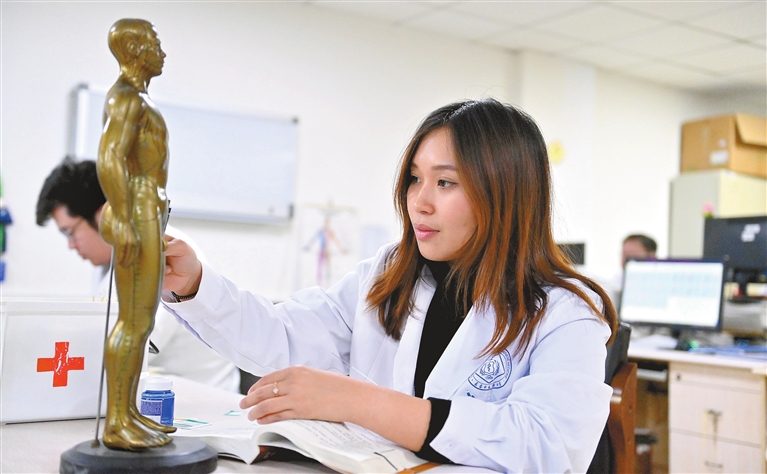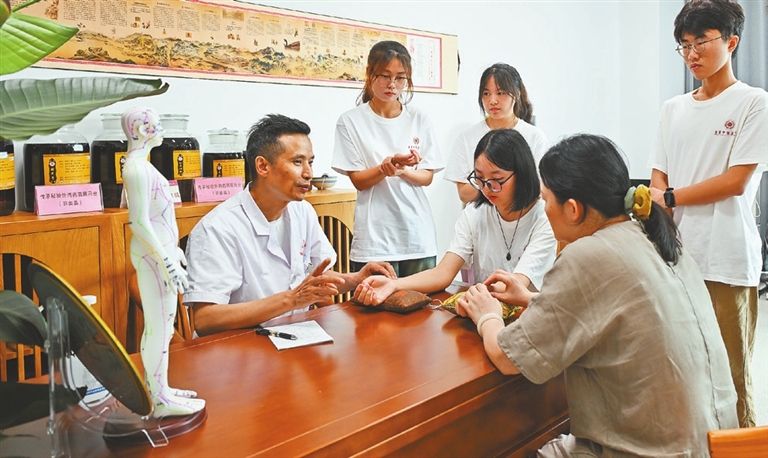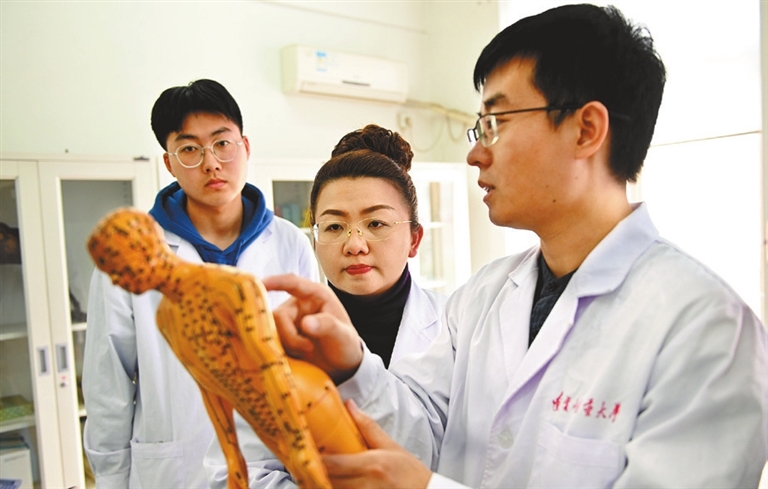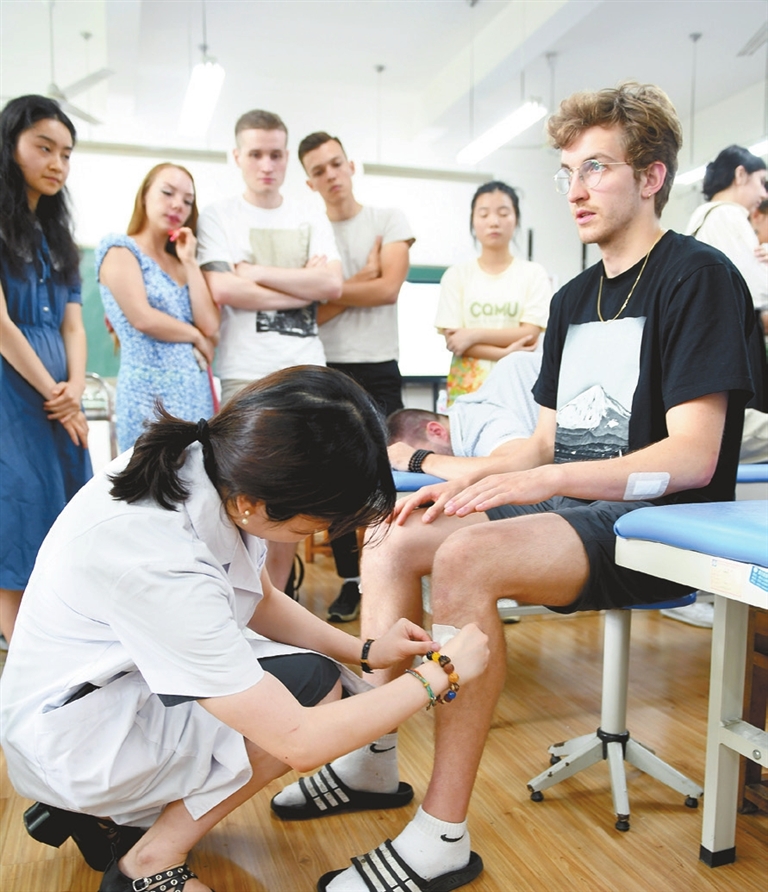





WHEN China’s universities specializing in traditional Chinese medicine (TCM) welcome new students this autumn, many are doing so with unmistakable pride — a growing number of high-achieving students are choosing to pursue TCM studies. Once perceived as a less popular academic path, TCM programs have seen a noticeable rise in admission scores across the country this year. At the Beijing University of Chinese Medicine (BUCM), the nation’s leading TCM institution, entry requirements for several programs climbed significantly compared to the previous year. Similarly, the Guangzhou University of Chinese Medicine also reported a robust increase in minimum admission scores. This upward trend reflects a broader revival of interest in ancient healing practices among the Chinese public — especially the youth. “I had decided to study TCM long before taking the gaokao,” said Zhang Honglin, an excited incoming freshman at BUCM. “As a former soccer player in high school, I struggled with recurring ankle ligament injuries, and it was TCM that finally cured me.” Ancient wisdom, new followers Rooted in classical Chinese philosophy that emphasizes the harmony between humans and nature, TCM is increasingly capturing the appetite of younger generations. From night classes to social media trends, young people are engaging with TCM like never before. In Heilongjiang, the Heihe Traditional Chinese Medicine Hospital is tapping into the trend by offering popular portable wellness products like herbal teas for liver detox and weight loss, mosquito-repellent sachets, and home health kits. In cities like Shanghai, herbal-flavored ice cream has become an unexpected hit with Gen Z. In eastern China’s Zhejiang Province, a local TCM institution offers evening sessions in Yijinjing — a traditional breathing and stretching exercise that quickly became a hit among working youth. Classes begin at 6 p.m. and consistently run overtime due to popular demand. “It’s common for our one-hour session to extend until 8 p.m. because everyone is so engaged,” said Zhang Yimo, a TCM expert at the institution. Similar scenes are unfolding in Jiangxi Province, where young students now have opportunities to learn herb identification and experience therapies like TCM massage and moxibustion. On social media platforms like Xiaohongshu, TCM content is flourishing. Young influencers gather millions of views sharing their journeys with Tai Chi, acupuncture, and herbal tea routines — blending traditional wisdom into contemporary wellness culture. The hashtag for Baduanjin, a traditional breathing and stretching exercise, has amassed nearly 900 million views. Another called TCM Tea has attracted 1.68 billion views as users share videos of moxibustion, sunbathing rituals, and herbal brews aimed at curing screen-related issues like insomnia and eye strain. This summer also saw the rise of TCM-themed night markets. At one such market in Gansu Province, crowds lined up for acupuncture, cupping, herbal foot baths, and pulse diagnostics. “This heat leaves me drained, sleepy, and listless,” said 21-year-old Yu Huiyan, as she extended her wrist for a pulse diagnosis. After experiencing positive results from previous TCM treatments, she now turns to the night market in search of herbal remedies. In Shenyang, capital of Liaoning Province, the TCM night market offers more than free consultations. It features zones for TCM-inspired cultural products, hands-on technique demonstrations, and youth activities, blending tradition with modern flair through crafts, games, and interactive learning. In the eastern city of Nanchang, Jiangxi Province, technology plays a key role at the TCM night market as TCM robots provide heat-sensitive moxibustion, digital pulse diagnosis, and 3D foot scans. “Young people today are more proactive about their health. TCM’s holistic approach of focusing on root causes and overall balance really resonates with them,” noted Deng Yong, a professor at BUCM. Growing health awareness has significantly boosted demand for TCM services. In 2024, TCM department visits across China’s hospitals surpassed 1.6 billion, up markedly from the previous year, according to data from the National Administration of Traditional Chinese Medicine. “More young patients, especially those with mental health concerns, are turning to TCM,” said Sun Anning, a TCM postgraduate intern at Beijing’s Dongzhimen Hospital. “My friends often ask me for health tips, like practicing Baduanjin or drinking herbal beverages,” Sun added. “TCM is a treasure of our Chinese nation, with expanding global influence,” said Da Chunhe, director of the Baiyin municipal health commission in Gansu. “As more young people experience and study it, they’ll understand TCM and benefit from it.” Supportive policies Government policy has also played a key role. In 2022, China released a plan emphasizing the need to expand TCM talent cultivation and improve youth education in the field. In 2024, State funding for TCM reached approximately 22.7 billion yuan (US$3.2 billion), a record high over recent years. An initiative was launched to support establishing over 1,150 specialized TCM departments nationwide. Meanwhile, more than 67,000 people obtained licenses for assistant TCM physician in 2024. “We truly feel the country’s strong backing for TCM,” Sun said. She plans to become a TCM doctor after graduation. Amid growing public demand, China has been rapidly expanding its TCM healthcare services and strengthening its professional workforce, creating abundant opportunities for TCM graduates like Sun. Official statistics show that by the end of 2023, the number of certified TCM physicians had exceeded 1.04 million. TCM has won greater international recognition in recent years. The Chinese Government encourages international TCM cooperation, including the opening of overseas TCM clinics. So far, China has signed TCM cooperation agreements with over 40 countries and organizations, and Chinese medical practices have reached 196 countries and regions. For instance, the Sanya Hospital of TCM has partnered with the Canadian College of Acupuncture and TCM to establish a new treatment center. China also plans to train 1,300 TCM professionals from Belt and Road countries by 2028. In April of this year, China took another significant step by integrating TCM promotion into its Healthy China Initiative. The policy advocates building a TCM health service system that covers all citizens, spans the entire life cycle, and integrates seamlessly into the whole healthcare process. Looking ahead, Zhang envisions bringing TCM to the global stage. “I plan to work abroad someday to promote traditional Chinese culture through TCM,” he said. “TCM is not only a medical treasure but also a cultural gem. With strong policy backing, rising health awareness, and an aging population, I believe TCM has a very promising future,” the freshman said.(Xinhua) | 
